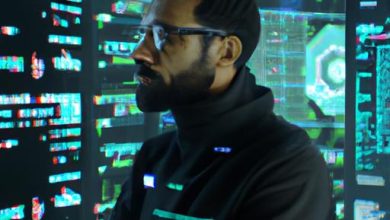How to Jam CCTV Camera: Understanding the Risks and Ethical Alternatives

Introduction
In our increasingly connected world, Closed-Circuit Television (CCTV) cameras have become ubiquitous, serving as a vital tool in ensuring public safety and security. These cameras, strategically placed in public spaces, monitor activities and deter potential criminal behavior. However, with the growing concerns about privacy infringement, some may be tempted to explore ways to jam CCTV cameras. In this article, we will delve into the subject of jamming CCTV cameras, understanding the risks involved, and exploring ethical alternatives to address these concerns.
The Purpose of CCTV Cameras and the Need for Prevention
CCTV cameras are designed to capture and record video footage of public areas, offering a sense of security by deterring criminal activities. These cameras play a crucial role in preventing crimes such as theft, vandalism, and assault. By monitoring these spaces, law enforcement agencies can respond promptly to incidents, ensuring public safety.
Preventing illegal activities is of utmost importance in a society that values security and privacy. Understanding the purpose and functioning of CCTV cameras enables us to appreciate their significance in maintaining law and order. However, it is equally crucial to address the concerns surrounding privacy and ethical implications associated with these surveillance systems.
As we continue, we will explore the reasons behind the desire to jam CCTV cameras, the potential risks and consequences, as well as ethical alternatives to ensure a balance between security and privacy in our communities.
**
Understanding CCTV Cameras
A. Explanation of How CCTV Cameras Work
CCTV cameras operate by capturing and recording video footage of specific areas, allowing for real-time monitoring and post-event analysis. These cameras consist of several essential components, including a lens, image sensor, processor, and storage system. The lens focuses light onto the image sensor, which converts the optical image into an electrical signal. The processor processes this signal, enhancing the video quality and compressing it for storage. The footage is then stored in a designated storage system, such as a Digital Video Recorder (DVR) or a Network Video Recorder (NVR).
B. Types of CCTV Cameras Commonly Used
There are various types of CCTV cameras available, each designed to suit specific surveillance needs. Some commonly used types include:
-
Dome Cameras: These cameras are characterized by their dome-shaped housing, providing a discreet surveillance option. Dome cameras are versatile and can be mounted on ceilings or walls, making them suitable for indoor and outdoor use.
-
Bullet Cameras: Bullet cameras, named for their cylindrical shape, are commonly used for long-range monitoring. With their weather-resistant design, they are ideal for outdoor surveillance in areas requiring a greater focal length.
-
PTZ Cameras: PTZ (Pan-Tilt-Zoom) cameras offer the ability to pan, tilt, and zoom, providing flexible coverage of large areas. These cameras can be remotely controlled, allowing operators to adjust the viewing angle and zoom in on specific details.
C. Key Components and Features of CCTV Cameras
To better understand CCTV cameras, it is crucial to familiarize ourselves with their key components and features:
-
Resolution: CCTV cameras come in various resolutions, ranging from standard definition (SD) to high definition (HD) and even ultra-high definition (UHD). Higher resolution cameras offer clearer and more detailed video footage.
-
Night Vision: Many CCTV cameras are equipped with infrared (IR) LEDs to enable night vision capabilities. These IR LEDs illuminate the area with invisible light, allowing the camera to capture clear footage in low-light conditions.
-
Motion Detection: Motion detection technology enables cameras to detect movement within their field of view. This feature can trigger alerts or recording, ensuring that suspicious activity is promptly captured.
Understanding the inner workings and variations of CCTV cameras allows us to appreciate their capabilities and limitations. However, it is essential to approach the use of these surveillance systems responsibly and ethically, as we will explore in the following sections.
**
Reasons for Jamming CCTV Cameras
In an era where privacy is a growing concern, some individuals may contemplate jamming CCTV cameras as a means to protect their personal space. However, it is essential to understand the reasons behind this desire and the potential implications it carries.
A. Legal Implications and Consequences
Jamming CCTV cameras is not only ethically questionable but also illegal in most jurisdictions. Deliberate interference with these surveillance systems can result in severe legal consequences, including fines and imprisonment. Engaging in such activities undermines the overall security infrastructure and hampers the efforts of law enforcement agencies in ensuring public safety.
B. Privacy Concerns and Ethical Considerations
Privacy is a fundamental right that individuals cherish. While CCTV cameras serve a legitimate purpose in deterring crimes, they also raise concerns about privacy infringement. Some argue that constant surveillance infringes upon personal liberties and creates a feeling of being constantly monitored. These concerns can lead individuals to consider jamming CCTV cameras as a way to protect their privacy.
However, it is crucial to recognize that addressing privacy concerns through illegal means is not the answer. Instead, engaging in dialogue with relevant authorities and advocating for responsible use of CCTV camera systems can foster a balance between security and privacy.
C. Preventing Surveillance and Intrusion
Another reason individuals may contemplate jamming CCTV cameras is to avoid being tracked or monitored. While this concern may arise from genuine fears of surveillance or intrusion, it is important to recognize that jamming CCTV cameras is not a foolproof solution. Resorting to illegal actions can result in additional legal consequences while failing to address the root causes of the concerns.
Rather than taking matters into one’s own hands, exploring legal alternatives and advocating for stronger privacy regulations can help address these concerns in a more effective and ethical manner.
**
Risks and Consequences of Jamming CCTV Cameras
A. Legal Consequences and Penalties
Engaging in the act of jamming CCTV cameras is not only ethically questionable but also comes with severe legal repercussions. Tampering with or disabling these surveillance systems is considered a criminal offense in many jurisdictions. Offenders may face charges such as vandalism, trespassing, or even more serious crimes depending on the extent of their actions.
Legislation varies from country to country, but the penalties for jamming CCTV cameras can include hefty fines and imprisonment. These consequences aim to deter individuals from interfering with public safety measures and protecting the integrity of surveillance systems.
B. Impact on Public Safety and Security
Jamming CCTV cameras can have far-reaching consequences, compromising the safety and security of the general public. These cameras serve as a deterrent to potential criminals, keeping a watchful eye on public spaces. By disabling or interfering with these systems, the overall safety of the community is jeopardized.
Without functional CCTV cameras, law enforcement agencies and security personnel lose a valuable tool in their efforts to prevent and investigate crimes. The absence of surveillance footage hinders their ability to identify and apprehend individuals involved in illegal activities, ultimately impacting the overall security of the community.
C. Dangers of Encouraging Illegal Activities
Deliberately jamming CCTV cameras not only poses risks to public safety but also encourages others to engage in illegal activities. When individuals realize that surveillance systems can be tampered with, they may be tempted to exploit this knowledge for their own purposes. This can lead to an increase in criminal behavior, as potential wrongdoers feel emboldened by the lack of monitoring and accountability.
Moreover, encouraging the disabling of CCTV cameras sends a message that disregards the importance of maintaining a safe and secure environment. By actively promoting such actions, individuals become complicit in undermining the efforts made to protect communities and uphold the law.
**
Ethical Alternatives to Jamming CCTV Cameras
A. Discussing Concerns with Relevant Authorities
When faced with concerns about CCTV cameras and their impact on privacy, it is crucial to engage in constructive dialogue with the relevant authorities. By expressing your concerns and seeking clarification, you can contribute to a better understanding of the need for surveillance while addressing any potential infringements on personal privacy.
Reach out to local law enforcement agencies, city councils, or community organizations responsible for installing and maintaining CCTV cameras. Express your concerns, ask questions, and request information about the specific purpose and guidelines for camera usage. This communication can help establish a productive relationship between the community and authorities, ensuring that CCTV systems are utilized responsibly and ethically.
B. Promoting Public Awareness and Education
Raising public awareness about the benefits and limitations of CCTV cameras can foster a sense of collective responsibility towards maintaining security without compromising privacy. Take the initiative to educate your community about the purpose, functioning, and legal aspects of CCTV systems.
Organize community meetings, workshops, or awareness campaigns to provide information about the role of CCTV cameras in deterring crime and enhancing public safety. Emphasize the importance of privacy and the need for responsible camera placement and monitoring. By empowering individuals with knowledge, they can make informed decisions and actively participate in discussions about CCTV camera usage in their neighborhoods.
C. Encouraging Responsible Use of CCTV Cameras
Instead of resorting to jamming, it is essential to advocate for responsible use of CCTV cameras. Encourage authorities to adopt and enforce strict guidelines for camera placement, ensuring they primarily cover public areas rather than intruding into private spaces. Additionally, emphasize the importance of regular maintenance and monitoring to prevent unauthorized access and misuse of recorded footage.
By promoting responsible use, you can help strike a balance between security and privacy. Encourage the implementation of technologies like facial blurring or pixelation to protect the identities of innocent individuals captured by CCTV cameras. These measures can alleviate privacy concerns while maintaining the effectiveness of the surveillance systems.
**
Conclusion
In conclusion, while the desire to jam CCTV cameras may stem from concerns about privacy infringement, it is essential to understand the potential risks and consequences associated with such actions. Jamming CCTV cameras not only carries legal implications but also compromises public safety and security.
Instead of resorting to illegal activities, there are ethical alternatives that can address the concerns surrounding CCTV cameras. Engaging in open discussions with relevant authorities, promoting public awareness, and encouraging responsible use of surveillance systems are all constructive ways to protect privacy while maintaining security.
By adhering to these ethical alternatives, we can strike a balance between safeguarding our personal privacy and ensuring public safety. It is through these collective efforts that we can build a society that values both security and privacy.
Remember, it is important to respect the law and work towards positive change within legal boundaries. Together, we can foster a safe and secure environment that respects the rights and privacy of individuals while effectively deterring criminal activities.
**
Conclusion: So above is the How to Jam CCTV Camera: Understanding the Risks and Ethical Alternatives article. Hopefully with this article you can help you in life, always follow and read our good articles on the website: Asian Wallpaper


